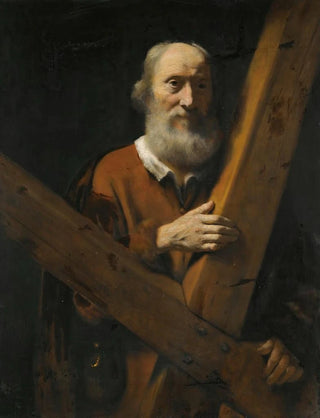Art print | Saint André - Nicolaes Maes


View from behind

Frame (optional)
Saint Andrew Art print - Nicolaes Maes – Captivating Introduction
In the fascinating world of baroque art, the "Saint Andrew" art print by Nicolaes Maes stands out for its emotional depth and technical mastery. This painting, which evokes spirituality and contemplation, invites the viewer to immerse themselves in a sacred moment. The depiction of Saint Andrew, the martyr apostle, is a poignant testament to Christian faith at a time when art served as a vessel for biblical stories. By contemplating this work, one feels a timeless connection to the values and beliefs that shaped society of the era, while also questioning our own spirituality.
Style and uniqueness of the work
Nicolaes Maes, a pupil of Rembrandt, developed a unique style, combining chiaroscuro with meticulous attention to detail. In "Saint Andrew," light plays a crucial role, illuminating the saint's face and creating a striking contrast with the dark background. This technique not only enhances the spiritual dimension of the scene but also highlights the subtle expressions that cross Saint Andrew's face. The drapery of his garment, rendered with remarkable precision, seems almost tangible, inviting the viewer to touch the canvas. This choice of colors, ranging from warm, golden hues to deep shadows, creates an atmosphere that is both serene and dramatic, where spirituality blends with tangible reality.
The artist and his influence
Nicolaes Maes, active in the 17th century, left his mark by his ability to capture the human essence. As a Dutch artist, he was not only influenced by the Flemish tradition but also contributed to the emergence of a style unique to himself, inspiring many contemporaries. His work, often focused on religious themes, reflects a deep understanding of human psychology. Through "Saint Andrew," Maes does not merely depict a saint but manages to convey an emotional experience that still resonates today. His influence endures, and echoes of his style can be seen in the works of many artists who followed, demonstrating the lasting impact of his artistic vision.
A decoration

Matte finish

View from behind

Frame (optional)
Saint Andrew Art print - Nicolaes Maes – Captivating Introduction
In the fascinating world of baroque art, the "Saint Andrew" art print by Nicolaes Maes stands out for its emotional depth and technical mastery. This painting, which evokes spirituality and contemplation, invites the viewer to immerse themselves in a sacred moment. The depiction of Saint Andrew, the martyr apostle, is a poignant testament to Christian faith at a time when art served as a vessel for biblical stories. By contemplating this work, one feels a timeless connection to the values and beliefs that shaped society of the era, while also questioning our own spirituality.
Style and uniqueness of the work
Nicolaes Maes, a pupil of Rembrandt, developed a unique style, combining chiaroscuro with meticulous attention to detail. In "Saint Andrew," light plays a crucial role, illuminating the saint's face and creating a striking contrast with the dark background. This technique not only enhances the spiritual dimension of the scene but also highlights the subtle expressions that cross Saint Andrew's face. The drapery of his garment, rendered with remarkable precision, seems almost tangible, inviting the viewer to touch the canvas. This choice of colors, ranging from warm, golden hues to deep shadows, creates an atmosphere that is both serene and dramatic, where spirituality blends with tangible reality.
The artist and his influence
Nicolaes Maes, active in the 17th century, left his mark by his ability to capture the human essence. As a Dutch artist, he was not only influenced by the Flemish tradition but also contributed to the emergence of a style unique to himself, inspiring many contemporaries. His work, often focused on religious themes, reflects a deep understanding of human psychology. Through "Saint Andrew," Maes does not merely depict a saint but manages to convey an emotional experience that still resonates today. His influence endures, and echoes of his style can be seen in the works of many artists who followed, demonstrating the lasting impact of his artistic vision.
A decoration






